#Smart Irrigation Systems
Explore tagged Tumblr posts
Text
Top 5 Eco-Friendly Technologies You Need to Know About
Introduction
Eco-friendly technologies are designed not to disturb nature and its processes. The domains of such technologies include energy, transportation, construction, waste management, and many more. This blog outlines 5 of the best eco-friendly technologies that create a visible difference as we walk towards becoming a sustainable world. Read to continue link
#Eco-Tech#Tagsadvanced recycling technology#composting innovations#eco-friendly living#eco-friendly technologies#eco-friendly transportation#electric vehicles#energy-efficient designs#EV advancements#green building materials#green tech#renewable energy#smart irrigation systems#smart wind farms#solar power innovations#sustainable building practices#sustainable future#sustainable technology#waste management solutions#water conservation technology#wind energy developments#Technology#Science#business tech#Adobe cloud#Trends#Nvidia Drive#Analysis#Tech news#Science updates
1 note
·
View note
Text
Irrigation Automation and Controls
Understanding Automation in Irrigation
Automatic irrigation employs devices like controls and sensors to regulate water flow, adjusting flow rates without human intervention. It finds applications in various sectors, including:
Agriculture
Commercial and Residential Landscaping
Golf Courses
Campuses
HOAs
And more
Functioning of Automatic Irrigation Systems
An automatic irrigation system comprises sensors that manage critical functions, such as starting, stopping, and controlling water flow. The control module, connected to buried valves, diverts water from the primary source into different zones based on programmed settings.
Key Components of Automation Systems
Major components of automated irrigation systems include:
Valve system: The primary valve connects to the water supply, controlled by timers to manage water release.
Underground piping: Typically made of polyurethane or PVC, these pipes connect to the main water source, ensuring even water distribution.
Sprinkler heads: These devices distribute water and come in various types like spray heads, rotor heads, bubblers, and emitters.
Sensors and controllers: Smart technology aids in optimizing water usage through programmable controllers and weather and soil sensors.
Vanden Bussche Irrigation's Role
Vanden Bussche Irrigation offers automatic irrigation supplies, including weather-based and soil-based controllers. They are committed to education and training while providing water-efficient products.
Automated Drip Irrigation
Automated drip irrigation systems minimize manual effort by using timers, sensors, and controllers to deliver moisture directly to roots or specific areas. Benefits include precise watering and reduced water and fertilizer use.
Importance of Automated Irrigation Systems
Automated systems ensure uniform watering, prevent overwatering or underwatering, and save labor costs. They protect crops, plants, and landscapes while conserving water.
Sensors in Smart Irrigation Systems
Smart irrigation systems employ sensors to monitor soil moisture, temperature, humidity, and ambient conditions. These sensors facilitate control through mobile apps.
Hunter and Rain Bird Controllers
Hunter and Rain Bird controllers are designed for efficient water management. They adjust schedules based on weather conditions and incorporate flow-sensing devices for leak detection.
Benefits of Automated Irrigation Systems
Automated systems enhance plant health, reduce labor, and conserve water, making them environmentally and economically advantageous.
Smart Irrigation Controllers
Smart controllers use data on soil conditions, evaporation, weather, and plant water absorption to adjust irrigation schedules intelligently.
Weather-Based Irrigation Controllers
Evapotranspiration (ET) controllers, a type of weather-based controller, factor in evaporation, transpiration, and meteorological data to determine irrigation schedules.
Soil-Moisture Controllers
Soil moisture sensors complement automated irrigation by measuring moisture levels in the soil, offering precise control.
Smart Irrigation Controllers Save Water and Money
Smart irrigation controllers conserve water, track flow rates, and simplify maintenance, making them a recommended choice.
Contact Vanden Bussche Irrigation
To enhance irrigation efficiency through automation and controls, you can contact Vanden Bussche Irrigation online for consultations.
Read More: https://vandenbussche.com/article/automation-and-controls-for-irrigation
#irrigation equipment#Smart Irrigation Systems#irrigation products#golf course maintenance#delhi irrigation supply
0 notes
Text
The Risks of Ignoring IoT Device Management

Modern water infrastructure is getting smarter. With the help of the Internet of Things (IoT), we are now able to manage water resources more efficiently. From agriculture fields to urban water systems, sensors and devices are helping monitor and control water flow, usage, quality, and waste.
However, these smart systems rely on more than just sensors and data. Behind every sensor and every connected water meter, there is a layer of management that keeps everything working smoothly. This is where IoT device management becomes essential.
What is IoT Device Management?
IoT device management refers to the tools and processes used to monitor, maintain, update, and secure connected devices in an IoT ecosystem. In water infrastructure, these devices include:
Smart water meters
Leak detector
Flow sensors
Pressure gauges
Water quality sensors
Irrigation controllers
Managing these devices means keeping them connected, ensuring they work correctly, sending updates when needed, and protecting them from security risks. Without proper management, even the best-designed system can fail.
Why IoT Device Management Matters in Water Systems
Water is a critical resource. We need to ensure that every drop is used wisely and that systems respond quickly to leaks, overuse, or contamination. IoT helps do that, but only if the devices are working properly.
Let’s look at the reasons why IoT device management is critical in modern water systems.
1. Keeps Devices Online and Functional
In a city’s water supply network or a smart irrigation system using IoT, hundreds of sensors and controllers may be in place. If a device goes offline or malfunctions, it could cause delays, water loss, or even safety issues.
With good device management, system operators can:
Monitor the status of each device
Get alerts when something goes wrong
Restart or reconfigure devices remotely
This helps reduce downtime and ensures a steady flow of data.
2. Helps in Remote Monitoring and Control
Managing a water system manually takes time and people. But with IoT, much of it can be done remotely. For example, in smart water management using IoT, operators can see real-time data from across the network on a dashboard.
Thanks to device management tools, they can also:
Update device firmware remotely
Adjust sensor settings from a control center
Restart or reset faulty devices
This saves time, money, and effort, especially in large or remote areas.
3. Supports Data Accuracy and Consistency
In systems like IoT monitoring for water pressure or flow, accuracy is important. Incorrect data could lead to wrong decisions, like supplying too much water to an area or failing to spot a leak.
When devices are not managed well, they may:
Send outdated readings
Report false values due to calibration issues
Miss sending data altogether
IoT device management tools help keep software up to date, verify sensor data, and ensure consistency across the network.
4. Ensures Security of Devices and Data
IoT devices can be targets for hackers. A weak link in your network could allow attackers to access critical water systems or steal sensitive data.
With strong device management, security steps include:
Encrypted communication between devices
Regular software and firmware updates
Authentication and access controls
Remote lockdown of devices if needed
These features help protect both the devices and the water system as a whole.
5. Enables Scalability
As demand for water increases, cities and farmers add more sensors, pumps, and meters. Without proper management, adding new devices becomes slow and confusing.
With centralized IoT device management, new devices can be:
Registered automatically
Assigned to the correct location or function
Configured with default settings
This makes it easy to grow from 10 devices to 10,000 without losing control.
Real-Life Example: Smart Irrigation System Using IoT
Farmers often use a smart irrigation system using IoT to reduce water waste. Sensors in the soil check moisture levels, and the system waters the field only when needed.
If one sensor fails or reports wrong data, a part of the field could stay dry, affecting crop yield.
With device management:
The system can alert the farmer to the faulty sensor
The sensor can be restarted or recalibrated remotely
The data can be cross-checked with nearby sensors
This helps ensure the system works correctly and crops get the water they need.
Real-Life Example: Smart Water Meters in Cities
In many urban areas, Smart Water Meters are used to track water usage in homes and buildings. These meters help detect leaks, overuse, and billing issues.
IoT device management is vital here because:
Meters need regular firmware updates to stay secure
They must remain connected to the network at all times
Data must be sent reliably and securely to the billing system
If management fails, residents might get incorrect bills or the city might lose valuable water data.
How IoT Monitoring Helps in Water Infrastructure
With IoT monitoring, water system managers can view data in real time. This includes:
Water pressure in different zones
Water quality levels at treatment plants
Pump status and energy usage
Rainfall and soil moisture in agriculture
But this only works if the devices behind the scenes are functioning well. That’s why IoT device management and IoT monitoring must go hand in hand.
Benefits of Investing in IoT Device Management
Investing in proper device management leads to several long-term benefits:
Reduced downtime: Problems are found and fixed faster
Better performance: Devices are always working as expected
Increased security: Threats are spotted early and blocked
Lower costs: Fewer people needed for manual checks and fixes
Longer device life: Updates and maintenance extend lifespan
These benefits apply whether you're running a city water network or a smart irrigation system using IoT in your farm.
Future of Water Systems with IoT
The future of water systems will rely heavily on automation, real-time monitoring, and data-driven decisions. In such a future, thousands of connected devices will work together to:
Detect leaks in real time
Adjust water flow based on demand
Monitor water quality continuously
Send alerts before a problem becomes serious
All of this depends on having well-managed devices. Without proper control, even the smartest system can turn unreliable.
Final Thoughts
Water is one of the world’s most important resources. As we move toward smart cities and precision agriculture, IoT device management will be key to keeping these systems working smoothly.
Whether it’s managing Smart Water Meters in cities or sensors in a smart irrigation system using IoT, having the right tools to monitor, update, and secure devices makes all the difference.
In short, IoT device management is the backbone of modern, smart, and sustainable water infrastructure.
0 notes
Video
youtube
Irrigreen Review | Smart Sprinkler That Waters Only Where You Need It
#youtube#Water-saving irrigation system#irrigreen review#Smart sprinkler system 2025#Eco-friendly lawn watering#smart sprinkler controller
0 notes
Text
Exploring the Future of Smart Homes with Dreame's Water Hookup Solutions
The smart home industry is evolving rapidly, and brands like Dreame are leading the way with innovative solutions that enhance our daily lives. One exciting feature that stands out is the water management capability, which allows for seamless integration of smart devices that manage water usage efficiently.
Dreame’s approach to water management technology not only simplifies home management but also promotes sustainability. With smart sensors and automated systems, homeowners can monitor water consumption, detect leaks, and even control irrigation systems from their smartphones. This means less waste and more control over water usage, contributing to a greener planet.
Imagine a home where you can schedule your watering systems or get alerts about potential leaks while you’re away. Dreame is making this a reality, ensuring that your home is not only smart but also eco-friendly. As we embrace these technological advancements, the future of smart homes looks brighter than ever, with brands like Dreame at the forefront of this revolution.
#sustainability#automated systems#Dreame#smart sensors#irrigation#water management#monitoring#eco-friendly
0 notes
Text
Smart Irrigation Systems using IoT And How Do They Work? Digicane Systems
Monitor Your Irrigation System with Tablet
Reduced water consumption is one of the best ways to combat climate change-related water shortages. However, it can be challenging during droughts or for growers who use conventional irrigation systems as they do not have a precise way to measure and control their water usage.
Smart Irrigation Systems using IoT allow growers to track and optimize water consumption. This ensures that you do not waste water, or give it away in excess. This article describes Smart Irrigation Systems using IoT, their working, and how they help to address water shortages.
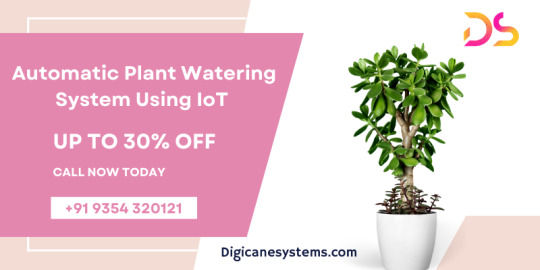
What Is A Smart Irrigation System?
You can integrate Smart Watering Systems using IoT into your existing irrigation system. They monitor, analyze and automate your water usage, reducing waste, detecting leaks and alerting you to any potential problems.
Instead of relying on manual watering methods, you can create an irrigation schedule based on the real-time requirements of your plants by using a smart watering system that is connected to all water related operations. This reduces runoff, erosion and evaporation, which helps to conserve water.
Smart Irrigation Systems using IoT: How They Work
In traditional irrigation, the grower manually opens and closes valves when needed. Smart water technology uses smart water valves that are embedded in your drip irrigation system to track water usage and allow you to control it remotely.
A smart water control valve has a valve controller and flow meter. It also contains wireless connectivity and power. The smart water valve collects data from flowmeters that measure the flow of water through your irrigation system. The smart valve then transmits this information via wireless to a cloud-managed software platform. You can then access the data from your computer or phone at anytime and anywhere.
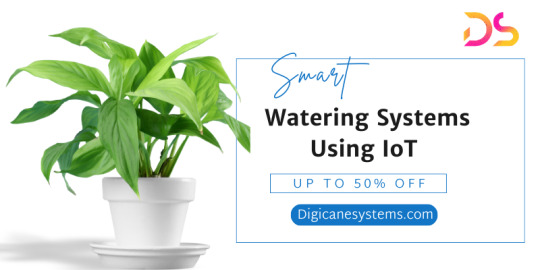
Smart Water Technology: Resist Water Shortages
Growers can take proactive measures to reduce their impact on the environment while we are working to reduce our carbon footprint by using methods like efficient transport and renewable energies. Smart water technology helps to avoid water shortages in several ways.
Leak Detection
A leaking irrigation system can cost up to 6,300 gallons per month. Leaks of this nature can have a negative impact on your water supply, and you may even lose water during times of drought. Leaks are the easiest way to reduce water consumption and monitor your supply.
The technology of leak detection gives you instant access to your most precious resource. It is possible to reduce water consumption on a farm without having to pay large upfront costs or shut down maintenance processes.
Measurement
Good data is the key to smart irrigation decisions. You can improve your water management by making sure that your irrigation system is equipped with smart sensors and controls.
Smart sensors in real-time allow you to determine the amount of water being used and where. Smart irrigation technology allows growers to be aware of how much water their crops have received. This gives them full visibility to where their water has been used, so they can take proactive measures to address any unplanned deviations in their irrigation schedules.
You can also find out more about the Automated Vehicles by clicking here.
Although irrigation timers and controllers are not a new idea, their cost, complexity and reliability have prevented them from being widely adopted. Automation is now much easier to use and more affordable with modern systems. You will never again overwater your plants by automating your irrigation. The valves will automatically shut off once the exact volume has been reached. You'll also save labor costs, since you won't have to hire someone to oversee and operate each valve.
For crops such as almonds, strawberries and wine grapes where water conservation is a major challenge, improved irrigation management can save up to 20 percent of the total water consumed.
Harnessing Real-Time Data
Growers need to be able to analyze data in real-time. There are a number of data solutions available to determine the optimal water schedule for crops, such as:
Soil Moisture Sensors
Plant Sensors And Pressure Chambers
Weather Stations
Satellite Imagery
Smart Watering Systems based on IoT often integrate these external data sources so that growers can create and manage their irrigation schedules in a single dashboard, and make adjustments easily, without having to jump from app-to-app.
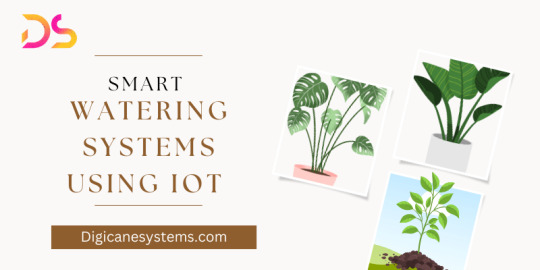
Preventive Maintenance
Smart irrigation technology detects problems by automatically monitoring water pressure and flow. You'll be able to detect problems before they turn into costly or dangerous situations. Leaks and clogs are the main causes of water waste in farming.
Sensor technology, data and automation allow growers to optimize irrigation to a new level. All these factors working together in harmony allows you to distribute water where it is needed and prevent waste.
Smart Irrigation Systems using IoT not only save growers time and money but can also reduce the amount water required for their crops while still achieving the same or better results.
How To Get Started With Modern Solution
Conserving water is essential for reducing the impact of climate change. Using water more efficiently is one way to achieve this. Smart Irrigation Systems using IoT allow growers to use less water for irrigation without risking their crops or livelihoods. We believe that conserving natural resources requires every drop to be counted. We have created a smart irrigation solution that allows you to automate your water use and track it in a simple way. Call us to find out how we can make irrigation easier and more efficient.
#smart irrigation system#smart irrigation system based on IoT#Smart irrigation system using IoT ppt#Smart watering system using IoT in india#Smart watering system using IoT pdf#Smart watering system using IoT project#Smart Watering systems based on IoT#Smart Watering systems with IoT#Smart Watering Systems using IoT#Smart watering system using IoT project report pdf#Smart watering system using IoT project report
0 notes
Text
Smart Tank Level Monitoring Using IoT
In the age of digital transformation, the Internet of Things (IoT) is revolutionizing how we manage and monitor various systems. One critical application of IoT is tank level monitoring, which is essential for efficient resource management across numerous industries. From water storage to fuel management, accurate monitoring of tank levels can prevent wastage, reduce costs, and improve safety.

Understanding IoT Tank Level Monitoring
What is IoT Tank Level Monitoring?
IoT tank level monitoring involves the use of connected sensors and technology to track the amount of liquid or material within a tank. This system provides real-time data on tank levels, enabling better decision-making and resource management. By integrating IoT technology, users can receive instant updates and insights, enhancing operational efficiency and responsiveness.
Components of an IoT Tank Level Monitoring System
Sensors: These are the core components of the system, responsible for measuring the tank’s content. Common types include ultrasonic sensors, which use sound waves to gauge levels, and radar sensors, which utilize electromagnetic waves for precise measurements.
Connectivity: The data collected by sensors is transmitted to a central system via various connectivity options like Wi-Fi, cellular networks, or satellite. This ensures that data is always accessible, regardless of location.
Data Processing: Once transmitted, the data is processed and analyzed. This can be done locally on-site or through cloud-based platforms, providing users with comprehensive insights and actionable information through dashboards and reports.
Benefits of IoT Tank Level Monitoring
Enhanced Efficiency
IoT tank level monitoring enables real-time data access, allowing for more efficient resource management. By continuously tracking tank levels, businesses can optimize their operations, ensuring that resources are used effectively and that supplies are replenished on time.
Cost Savings
One of the most significant benefits of IoT tank level monitoring is cost savings. By preventing overflows, leaks, and other issues, businesses can reduce wastage and avoid costly emergency responses. Additionally, optimizing tank usage helps in managing inventory more effectively, lowering operational costs.
Improved Safety
Monitoring tank levels in real-time helps in identifying potential problems before they escalate. For example, early detection of low levels or leaks can prevent accidents and hazardous situations, thereby enhancing overall safety for both personnel and the environment.
Environmental Impact
Efficient tank management also contributes to environmental sustainability. By minimizing wastage and preventing spills, businesses can reduce their environmental footprint and comply with regulations aimed at protecting natural resources.
Key Features to Look for in IoT Tank Level Monitoring Systems
Accuracy and Reliability
The primary function of a tank level monitoring system is to provide accurate measurements. Therefore, it is crucial to choose systems with high precision and reliability. Look for sensors that are well-calibrated and capable of delivering consistent performance.
Real-Time Monitoring
Immediate updates on tank levels are essential for effective management. Systems that offer real-time data allow for prompt responses to any changes or issues, ensuring that operations remain smooth and efficient.
Ease of Integration
The IoT monitoring system should seamlessly integrate with existing infrastructure. Compatibility with other systems and ease of installation are key factors to consider, as they impact the overall efficiency and cost of implementation.
User-Friendly Interface
A clear and accessible dashboard is vital for interpreting the data effectively. The interface should be intuitive, allowing users to easily navigate through the information and make informed decisions based on the data presented.
Applications of IoT Tank Level Monitoring
Water Management
In residential and municipal settings, IoT tank level monitoring helps in managing water resources efficiently. By keeping track of water levels in storage tanks, authorities can ensure a consistent supply, detect leaks, and prevent shortages.
Agriculture

In agriculture, IoT tank level monitoring is used to manage irrigation systems. By integrating with smart irrigation systems, farmers can monitor water levels in irrigation tanks to ensure that crops receive the optimal amount of water. This leads to better yields and resource conservation, as water is used more efficiently and precisely based on the crops' needs.
Future Trends in IoT Tank Level Monitoring
Advancements in Sensor Technology
The field of sensor technology is constantly evolving. Future advancements may include more accurate sensors with extended ranges and improved reliability. These developments will enhance the effectiveness of tank level monitoring systems and expand their applications.
Integration with Other IoT Systems
As IoT technology continues to advance, integration with other smart systems will become more prevalent. For example, combining tank level monitoring with predictive maintenance and smart grid systems can further optimize resource management and operational efficiency.
Conclusion
IoT tank level monitoring offers significant benefits, including enhanced efficiency, cost savings, improved safety, and reduced environmental impact. By leveraging real-time data and advanced technology, businesses and municipalities can manage their resources more effectively and address potential issues before they become critical. As IoT technology continues to evolve, the capabilities and applications of tank level monitoring systems are likely to expand, providing even greater opportunities for optimization and innovation.
0 notes
Text
#augusta green sprinklers inc.#Sprinkler Systems Mississauga#Augusta Green#smart irrigation#lighting systems
0 notes
Text
How Big Should Your Farm Be to Make a Profit?
Many new agripreneurs believe that the size of their farm will determine how profitable they’ll be. However, you can be profitable whether you’re farming 1 hectare or 100 hectares; it all depends on how you farm. When it comes to land, the most important thing to consider is not the number of hectares at your disposal, but rather the commodity that you farm and how you manage and control costs.…

View On WordPress
#Agricultural business success#Crop diversification benefits#diversified farming#Effective irrigation systems#Efficient farming methods#Farm cost management#Farm operational costs#Farm planning strategies#Farm productivity tips#farm profitability#Farm risk management#Farming market trends#Farming technology#high-value crops#High-yield crop varieties#Large-scale farming#Livestock integration#Low-cost farming solutions#Micro-farming#Modern farming tools#Niche crop farming#Organic farming practices#precision farming#Profitability in agriculture#Small farm equipment#Small-Scale Farming#Smart farming techniques#Starting a farm business#Successful farming examples.#sustainable farming
1 note
·
View note
Text
LetPot LPH-Max 21 Pods Hydroponics Growing System, [2 Large pods Tray & Automatic Irrigation] Smart Hydroponics Growing System Indoor Garden, APP & WiFi Controlled Self-Managed Nurturing & Watering
LetPot LPH-Max 21 Pods Hydroponics Growing System, [2 Large pods Tray & Automatic Irrigation] Smart Hydroponics Growing System Indoor Garden, APP & WiFi Controlled Self-Managed Nurturing & Watering Product Description & Features: 🥇[New Upgrade]: The new version upgrade includes TWO EXCLUSIVE LARGE-HOLE planting trays, suitable for larger fruits and flowering plants! With the second-generation…
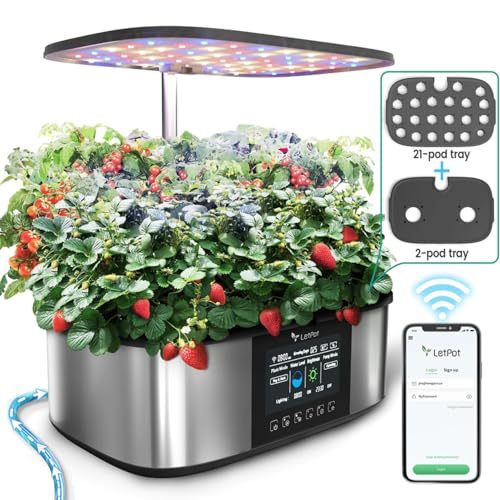
View On WordPress
#2#21%#AeroGarden#App#Automatic#Controlled#Garden#Growing#Hydroponics#Indoor#Irrigation#Large#LetPot#LPH-Max#Nurturing#Pods#Self-Managed#Smart#System#Tray#Watering#WiFi.
0 notes
Text
The Best Eco-Tech Products for an Energy-Efficient Home
Introduction
The newly developed innovations regarding eco-tech products have become necessary when building an energy-efficient house. Yet such innovation does not only lead to energy consumption reduction but also pulls efforts towards a sustainable future. Well, TechtoIO is forever committed to bringing the latest eco-tech products that make your home smarter, greener, and more performant. Here are the top products to make your house a comfortable and efficient sanctuary.
Now, with the Smart thermostats are one of the game-changers in energy-efficient homes. They learn your habits and optimize the temperature based on your habits and preferences so energy isn’t wasted when you’re not around. Among other smart devices, energy usage reporting with remote control in some popular monitored models include Nest Learning Thermostats and Ecobee SmartThermostat with voice control.
Optimized with significant energy savings, courtesy of smart thermostats, the efficiency of heating and cooling systems can increase. Read to continue link
#Eco-Tech#Tagsbenefits of smart thermostats#best eco-tech products 2024#best LED lighting options#eco-friendly home products#electric vehicle charging stations#Energy Star rated appliances#energy-efficient lighting solutions#home energy monitoring systems#how solar panels work#integrating smart home devices#reducing home energy consumption#smart home energy management#smart irrigation systems#smart plugs and power strips#smart thermostats for energy efficiency#solar panels for homes#sustainable home technology#top energy-efficient appliances#water-saving devices for homes#weatherproofing for energy efficiency#Technology#Science#business tech#Adobe cloud#Trends#Nvidia Drive#Analysis#Tech news#Science updates
1 note
·
View note
Text
youtube
Agricultural technology is using technology in agriculture, horticulture, and aquaculture to improve yield, efficiency, and profitability. In this video, we're deep-diving into the fertile fields of tech and agriculture the future of farming. Get ready to witness how groundbreaking technology revolutionizes farming practices, from the seeds sown to the crops harvested!
Agriculture technology, often referred to as "AgTech" or "agricultural technology," encompasses a wide range of innovative solutions, tools, and practices that aim to enhance the efficiency, productivity, sustainability, and profitability of agricultural processes and systems. It involves the integration of modern technologies, such as information technology, data analytics, automation, biotechnology, and more, into various aspects of agriculture to address the challenges and opportunities faced by the global farming community.
Precision farming involves the use of sensors, drones, satellites, and GPS technology to collect and analyze data related to soil composition, moisture levels, weather patterns, and crop health. By gathering real-time information, farmers can make informed decisions about when to plant, irrigate, fertilize, and harvest, thereby minimizing waste and maximizing yields.
Robotic technology is revolutionizing labor-intensive tasks in agriculture. Robots can plant seeds, and weed fields, apply pesticides precisely, and even harvest crops. Automation reduces the need for manual labor, which is increasingly scarce and expensive in many regions.
With the growing challenges of land scarcity and changing climate patterns, vertical and indoor farming systems have emerged. These systems utilize controlled environments, artificial lighting, and efficient space utilization to grow crops in vertically stacked layers or indoor facilities, allowing year-round production and reduced dependency on traditional agricultural land.
The future of farming is undergoing a technological revolution that promises increased efficiency, sustainability, and resilience in the face of global challenges. AgTech solutions are not only changing the way food is produced but also fostering a more interconnected and data-driven agricultural landscape, ensuring that we can feed the world's growing population while safeguarding our planet's resources.
#agriculture#farming#farming technology#future of agriculture#agriculture technology#tech in agriculture the future of farming#tech in agriculture#LimitLess Tech 888#importance of technology in agriculture#agriculture farming#modern agriculture technology#future of farming#the future of farming technology#modern agriculture machine#sustainable agriculture#sustainable farming#technology in agriculture#tech and agriculture#smart irrigation system#vertical farming#Youtube
0 notes
Text
youtube
Agricultural technology uses agriculture, horticulture, and aquaculture technology to improve yield, efficiency, and profitability. In this video, we're deep-diving into the fertile fields of tech and agriculture the future of farming. Get ready to witness how groundbreaking technology revolutionizes farming practices, from the seeds sown to the crops harvested!
Agriculture technology, often referred to as "AgTech" or "agricultural technology," encompasses a wide range of innovative solutions, tools, and practices that aim to enhance the efficiency, productivity, sustainability, and profitability of agricultural processes and systems. It involves the integration of modern technologies, such as information technology, data analytics, automation, biotechnology, and more, into various aspects of agriculture to address the challenges and opportunities faced by the global farming community.
Precision farming involves the use of sensors, drones, satellites, and GPS technology to collect and analyze data related to soil composition, moisture levels, weather patterns, and crop health. By gathering real-time information, farmers can make informed decisions about when to plant, irrigate, fertilize, and harvest, thereby minimizing waste and maximizing yields.
Smart irrigation systems utilize sensors and data analysis to determine when and how much water crops require. This helps prevent over-irrigation and water wastage, resulting in water conservation and improved crop quality.
The future of farming is undergoing a technological revolution that promises increased efficiency, sustainability, and resilience in the face of global challenges. AgTech solutions are not only changing the way food is produced but also fostering a more interconnected and data-driven agricultural landscape, ensuring that we can feed the world's growing population while safeguarding our planet's resources.
Tech in Agriculture: The Future of Farming
#agriculture#farming#farming technology#future of agriculture#agriculture technology#tech in agriculture the future of farming#tech in agriculture#LimitLess Tech 888#importance of technology in agriculture#agriculture farming#modern agriculture technology#future of farming#the future of farming technology#modern agriculture machine#sustainable agriculture#sustainable farming#technology in agriculture#tech and agriculture#smart irrigation system#vertical farming#Youtube
0 notes
Text
Chinese History: Great Yu Cures the Waters
Modern China has over a hundred thousand waterways and several of the biggest rivers in the world. As the entire east side of China is coastside, China’s biggest major cities (Shanghai, which literally means On-the-sea, Shenzhen, Hong Kong etc) are all along the ocean, with Beijing not far inland.
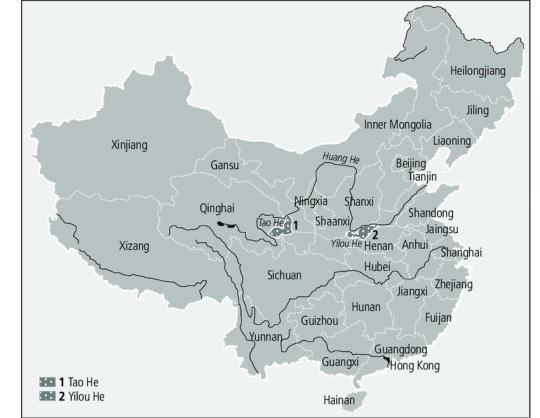
Do not start a Hong Kong argument with me- I am JUST SAYING that in ancient times, Hong Kong was an important part of the dynasties’ power that relied on water. I have no patience for Hong Kong arguments. Seriously. PLEASE.
Other major cities, like Chongqing, Nanjing and Wuhan all lie along the Yangtze River. This is very natural- civilisation sprouts up where there is running water.
WARNING: GOING OFF ON A TANGENT, PLEASE SKIP IF YOU’RE HERE JUST FOR THE MYTHOLOGY, I WILL MARK THE BEGINNING OF THE MYTH WITH A CAT PICTURE
I am going to do a quick advertisement for my home city, Shanghai, which has the Huangpu River running through it (making up the Bund, or Outer Beach) and Lujiazui. If you’re going to visit China, I would say Shanghai is the one place where foreigners will have the easiest time.
It’s probably the city most influenced by foreign culture- most people don’t speak fluent English but if you’re staying in populated areas like Xujiahui, Xintiandi, Lujiazui etc you will have no problem since the people you run into will speak at least a few words of English, metro stations and malls will have English signs, etc.
Shanghai, within China, has a reputation of being rich and snobby but I feel like that’s a better option for a first-time foreign traveler. Please visit Shanghai! If you have any questions about Shanghai feel free to ask.
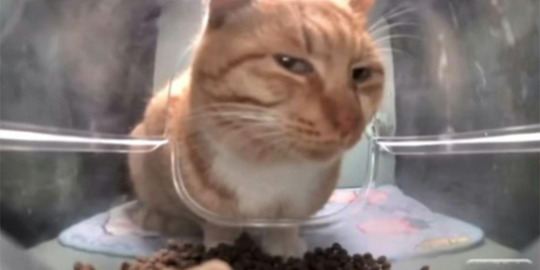
OKAY WE’RE BACK ON TRACK. Say hi to Mr. Fresh.
China has an excellent agricultural background and due to government efforts (no this is not propaganda) most of the entire country has access to clean running water, though this is still an ongoing effort since China is so huge and some rural areas need to be developed for canals to be built.
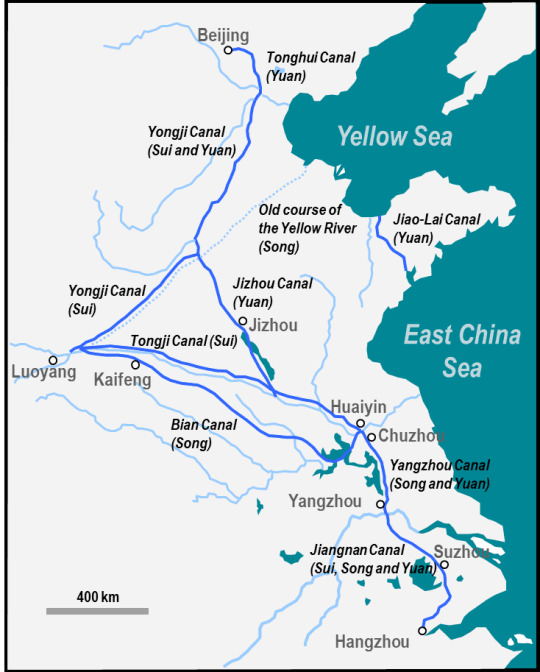
This is due to the canal, irrigation and waterway system that has been in place for centuries and that we constantly update and improve as China’s population grows. (However, with global warming and climate change, regions of China are beginning to face drought- the government is currently building more infrastructure)
But back in ancient times, China still had a huge population without the technology of today. How did China deal with trying to wrangle water into place?
This is due to the help of Yu the Great.
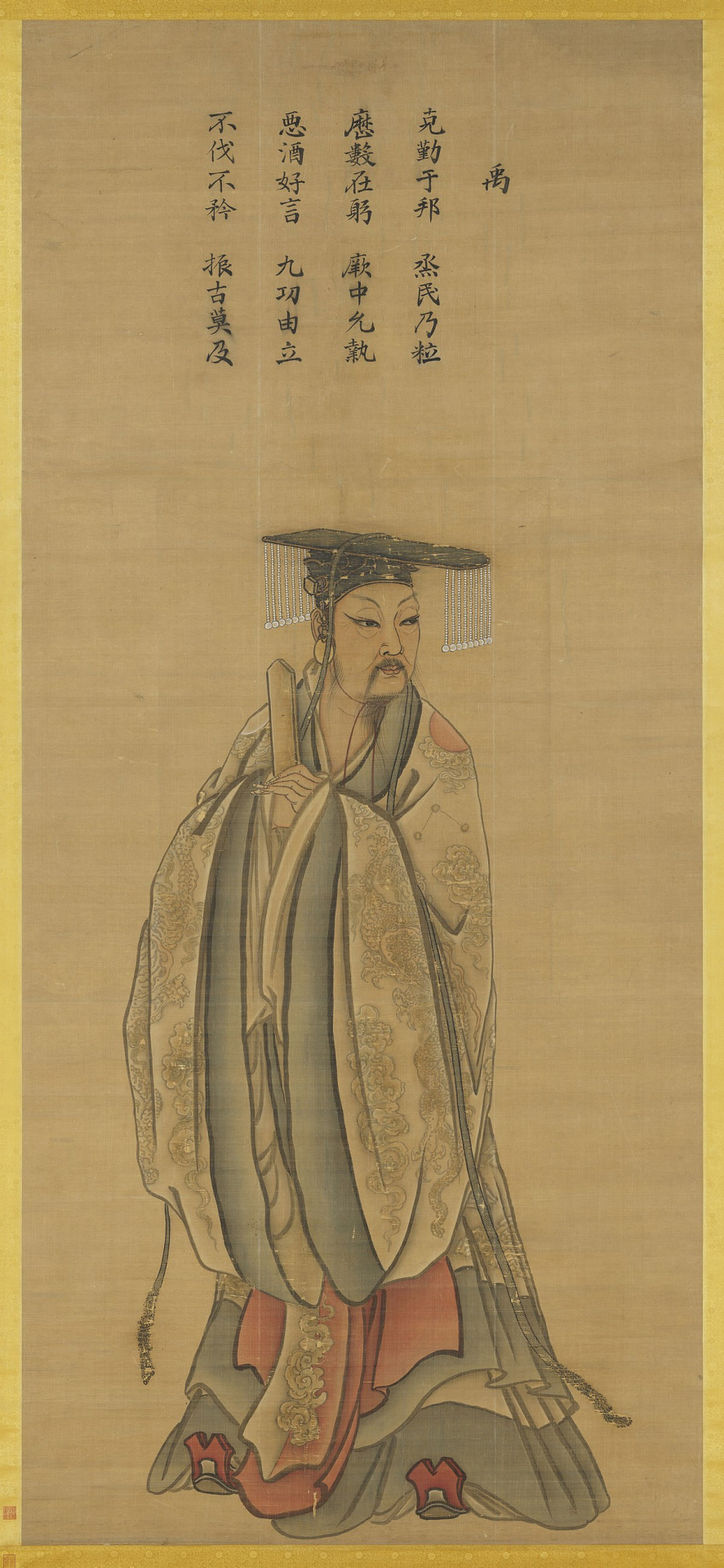
If China struggles with water today, back then it was a disaster. Flooding, drought and famine were very common back in the day of someone called Yu (4000 years ago). His full name is unknown- he is referred to as Yu, or Great Yu (Da-yu).
Yu was either a very high-ranking official in the court or a descendant of an Emperor and thus part of the royal family. Either way, he was an important person. He and his father Gun (pronounced Gwun, not American gun) were both large-scale civil engineers, meaning they designed infrastructure for the Emperor.
Water-related natural disasters were so common that the empire could not develop socially or economically, and the people were commonly dying. Farmland was scarce and so agriculture was unstable (which is terrible for a civilisation), and flooding often destroyed people’s homes.
Gun (Yu’s father, remember) was sent to figure out a way to stop the disasters. He spent a very, very long time trying to design a set of dams. His solution was just to plug up the waters.
None of this worked, even though he invested his entire life into it.
Emperor Yao gave the job to Yu instead. Yu, who was smart and meticulous, decided he’d learn from his father’s mistakes and stop trying to plug the water. Instead, he’d try to divert it and make the water benefit the people.

Artist 贫烦 on Xiaohongshu
Yu studied his father’s work for a long time and figured out that the solution was to let the water flow along to the sea instead of spreading out with nowhere to go.
In the end, Yu spent decades working with the people (he was physically there, doing manual labour, which is impressive of him) digging a series of irrigation canals along the mountains and valleys of rural China.
These waterways would be filled with the waters from the floods and were cleverly designed so they would provide flowing water to nearby villages and had to be just deep enough but not too deep that the water would flow perfectly from the source all the way to the sea.

We all know how huge China is- what makes Yu so famous isn’t just that he designed some waterways or even that he personally helped the people, but it’s that he was able to design irrigation canals so perfectly-made that they fit all across China.
That is tens of thousands of kilometres of waterways where the height, width and depth of each canal has to be just right so the waterflow doesn’t stop halfway or overflow. He did it without modern technology either.
There is a myth in which once he made a mistake in timing and a flood came just as he and the workers had finished building the skeleton of a key waterway.
Since the waterway wasn’t finished, the flood almost destroyed the frame- Yu, without caring for his safety, jumped into the water and directed the workers to help salvage the canal construction.
The gods, being touched by his bravery, sent a mythological dragon (dragons are water deities, remember) to help him and save his life.
While Yu probably did exist and did do all these wonderful things, there is also a myth where instead of digging the waterways he rode on the back of a giant mythical turtle whose slithering tail carved the waterways instead. I like to believe in the manual labour story.
Once Emperor Yao aged and died, since Yu was so revered for his deeds, he ascended and became the new Emperor.
After his death, he was deemed Yu the Great (or Big Yu, I guess, directly) and is honored as one of the founders of the powerful Chinese civilisation. His myth is known as 大禹治水, or Yu the Great Cures the Waters.
Chinese myths, except for the fantastical ones of deities, usually refer to gods or people doing great things for the citizens. The most respected figures (beyond Wukong, Ne Zha, Erlang, and all the big honchos up in the sky from novels) are the ones that help the ordinary people.
13 notes
·
View notes
Note
Hiiii how about a prompt for Further Down Road One, political marriage!Shikasuke, maybe something from an Uchiha's POV on the Shikabane-hime's meteoric rise in power, international acclaim, and political capital? And how it ripples out onto the clan as a whole?
I mean, the point of Road One is that the arranged marriage itself already does SO MUCH to change the trajectory of the Uchiha clan’s fate for the better that, basically, everything else after that is kind of a bonus. The fact that Shikako’s smart and powerful and a good person is NICE, yes, but just being engaged to Sasuke already earned so much approval from the clan as a whole that it’s just kinda… ehhhh…
Although… and this somewhat of a tangent to the prompt… it would be funny if… okay, let me set this up by saying: I don’t necessarily like Itachi as a character. When he was kind of a psychopath and apparently just murdered his entire family to test his power, that was at least a… strength of will or conviction that kind of resonated thematically. Like, what if Will of Fire goes bad kind of thing. Or the pressures of being clan heir, of being pushed too hard and too fast, would lead to a genius of violence snapping and using said violence. Then when it turns out he was given orders to murder his entire family and his one condition was that Sasuke would get to live is like… what the fuck dude. It’s both backtracking to make Itachi weaker as a character and also, somehow, even more of a psychopath in my opinion. And, like, sure, Danzo maybe used Shisui’s Sharingan to unbreakable genjutsu him into it, but I don’t think that really absolves Itachi.
All that being said, theoretically in this kinder world of Road One, we never get to that point. Additionally, there’s less pressure on Itachi to continue to excel SO OVERTLY since the clan isn’t getting isolated and also because Shisui is still there and alive to share the burden.
BUT, I do still… the idea that the Uchiha elders have been wanting one of the clan to become Hokage is something that I hold to be true unless proven otherwise. I do think the clan elders would push more for Itachi to be Hokage—because he is clan heir and so has the pedigree, while Shisui (just as powerful, literally Flee On Sight in the bingo books at such a young age) I think we’ve fandom agreed is an orphan or at least a lesser branch of the Uchiha clan.
Anyway, all of the above leads me to: Shisui and Itachi trying to PR campaign for their sister-in-law Shikako (who WILL be an Uchiha once the marriage actually) to be the new “best candidate” for an Uchiha Hokage. Like, really just them listing off all of her accomplishments to not only the Uchiha elders but the rest of the clan (who, again, already quite like her).
I also think, in this universe, that Shikako would DO SOMETHING about Sora-ku once she feels a little more comfortable making decisions—or, at least, making proposals with attached logistics—for the Uchiha clan. Like. It’s a huge chunk of territory that seems to be an abandoned city. But it’s apparently functional enough to have a community of sorts of black marketeers and a support system. Like, it’s not so out of the way of things that nobody bothers with it, which implies that it could be rejuvenated with the time and resources. I think I read a theory once that it’s because Senju used their skills to desertify the area so there just wasn’t enough food to support a city of that size. BUT, now they’ve got Shikako. And Shikako’s connections. Whether that is the ANY clan alliance or Tenzo/Yamato or upper echelons of Hidden Mist’s administration (Haku is an ice user, yes, but like he and Zabuza wouldn’t throw a squad of Mist nin with water nature to help with irrigation at Shikako’s request for free) or even the literal oasis creating ancient god Gelel.
So, you know, she’s more than proven herself to the world. And with the Sora-ku rejuvenation, already brought a level of prosperity to the Uchiha clan than they could ever imagine. “Shikako for Hokage” is not a hard sell for Shisui and Itachi whatsoever (and also, they do think Sasuke would be so happy as her First Gentleman/trophy husband)
Yeah, that’s kind of all I can think of for this prompt in terms of it being different than how the Nara clan or DoS canon clans for that matter would view her meteoric rise. Hope you enjoyed, anon.
#jacksgreyson#anonymous#ask box advent calendar#down every road#dreaming of sunshine#shikako nara#itachi uchiha#shisui uchiha#character analysis#meta analysis#brainstorm
64 notes
·
View notes
Text
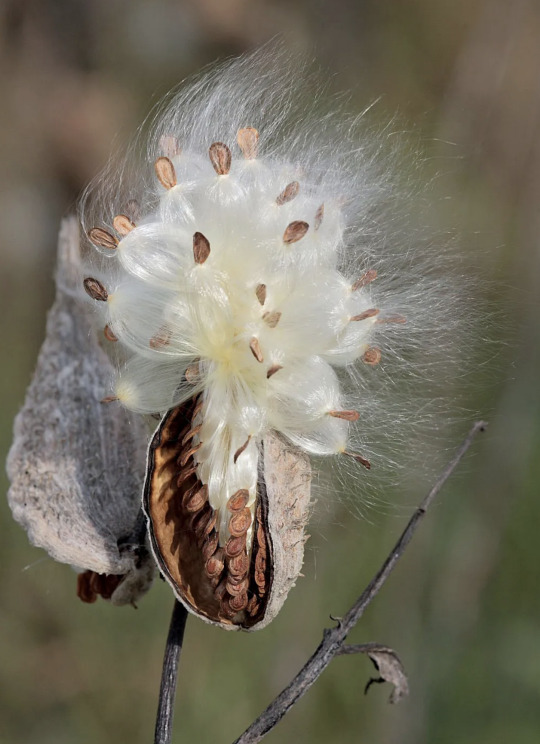
A couple of days ago, I was collecting seeds from the milkweed pods in our yard. Having not done this before, but being fully aware of the fuzzy stuff that flies out of the pods, I was battling fuzz (technically, "floss") as I was pulling off and storing the seeds. Then I got smart, and decided to cut a slit in the pods and then gently pull out the mass of floss and seeds, and then just pulling the seeds off and dropping then into the container. As I was doing that, I noticed how super soft the floss was as I pulled it fresh out of the pods, and wondered........do any clothing manufacturers use this stuff? Did a Google search, and learned....yep!
Excerpt from this story from Happy Eco News:
As consumers demand more eco-conscious apparel, brands are getting creative with natural materials that keep warmth in and environmental harm out. One unlikely hero emerging from prickly planted fields is the common milkweed—yes, literally plucked straight from the wild. While best known as the sole food source for iconic, struggling Monarch butterflies, milkweed’s hidden potential is nestled right inside its fluffy, silken floss. This fleecy fiber is an amazing natural insulator and is finding a new application in jackets, parkas, boots, and ski gloves for humans.
As outdoor apparel companies race to reduce environmental impacts, milkweed clothing insulation is proving a promising substitute for conventional insulation fillers—one aligned with cleaner agricultural systems. Its hollow-cored fluff offers an animal-friendly, biodegradable alternative to goose down. Unlike petroleum-based synthetics like polyester fibers, milkweed fills garments with a regeneratively sourced material that decomposes rather than lingering for centuries in landfills.
With conscious consumerism accelerating across industries, apparel buyers now consider impacts far beyond cost and quality when evaluating purchases. An unlikely hero from both suffering North American grasslands and climate crosshairs is rapidly gaining traction as a sustainable insulation material – common milkweed floss. Beyond keeping heat in and winter out with insulating performance rivaling goose down, milkweed rates exceptionally on multiple sustainability indicators resonant with eco-conscious consumers.
As a native perennial thriving on marginal lands, milkweed flourishing requires no irrigation, fertilizers or pesticides – regrowing reliably year after year. From a toxicity and allergen standpoint, milkweed avoids issues associated with many synthetic insulations or down. And supporting milkweed crop expansion helps reverse monarch butterfly declines blamed on agricultural habitat loss. For shoppers concerned over microplastics shedding into waterways from standard fleece, milkweed offers a soft, homegrown, biodegradable alternative. In short, milkweed checks all the boxes for socially mindful consumers seeking future-focused apparel that balances functionality with ethical, regenerative supply supporting threatened pollinators.
Signaling the momentum of milkweed clothing insulation, major brands like Patagonia are incorporating the fluff through novel partnerships with companies like Vegeto Textiles. Dedicated milkweed plantings bandwidth habitat zones while fibers make their way into garments. Other types of textile manufacturers are also jumping on board, some with announced plans to insulate blankets and quilts with milkweed.
Still, despite its promise, milkweed clothing insulation remains in its infancy. Technological barriers to processing millions of floss strands into a stable textile filling have just recently been worked out. Machinery and techniques to update this long-known application concept into a scalable commercial reality. Companies have worked for years honing best practices for taking raw milkweed fluff through cleaning, drying, and fiber alignment steps to transform fuzzy floss into outdoor-ready filling. Advancements in the coming decade will further improve integration potential across diverse textile products, opening doors for milkweed clothing insulation in everything from t-shirts to winter boots.
18 notes
·
View notes